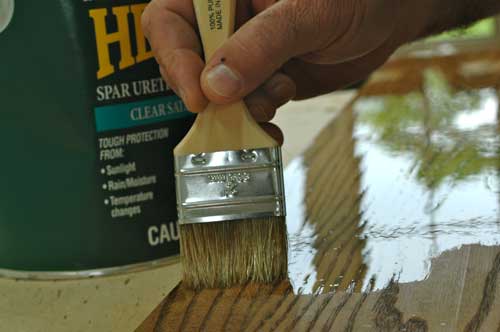 In 2005 I built and installed a large wooden entranceway and screen door feature at a big lakeside place, and I’d like to help you avoid some trouble that’s set in since. Although the door still swings well and the proportions of the screened sidelights look great, I left the jobsite before telling the client how to finish the wood. And before I could get back and warn against the worst possible finishing choice they could make, they made it.
In 2005 I built and installed a large wooden entranceway and screen door feature at a big lakeside place, and I’d like to help you avoid some trouble that’s set in since. Although the door still swings well and the proportions of the screened sidelights look great, I left the jobsite before telling the client how to finish the wood. And before I could get back and warn against the worst possible finishing choice they could make, they made it.
In their reasonable quest to achieve and maintain a furniture-grade appearance on their new entrance way these people brushed on two coats of ordinary, indoor urethane. By the end of that first summer my lovingly crafted project was showing the telltale grey streaks caused by a clear wood finish breaking down in sunlight. Now it’s much worse, with the only remedy being a long, slow stripping and sanding process that’ll probably never happen. And the part that really bugs me is that all this could have been avoided with something called spar varnish.
Many different wood finishes are generically called “varnish”, but when it comes to protecting exterior wood underneath a truly clear film, spar varnish is one of the only options worth considering. Originally developed in the days of wooden sailing ships, spar varnish (also called spar urethane) is made to resist the three main factors that cause other clear wood finishes to fail outdoors:
- breakdown in UV light
- moisture-related peeling
- cracking caused by seasonal expansion and contraction of the underlying wood
As it turns out, marine environments are still the most rigorous testing grounds for assessing the durability of clear, exterior wood finishes in action, and Canada’s classic sailing ship the Bluenose II is the best example I’ve seen.
Like well-maintained, traditional wooden boats everywhere, the Bluenose II is at least as much a piece of fine, floating furniture as it is an ocean-going vessel. Thousands of square feet of wood are coated and recoated each year and that got me curious: How do they do it? The wood surfaces on Bluenose II look so fine, exactly what are they doing out there on the east coast?
I discovered that the woodwork on this ship is mostly mahogany, with the mast being Douglas Fir. Some high strength items like mooring posts are made of oak. The crew maintains wood finishes throughout the sailing season, and success involves more than just incessantly brushing on yet another layer of varnish. There are two distinct approaches used on the Bluenose II.
Finishes that are just beginning to look tired are renewed with a light sanding to scuff up the old varnish before fresh coats are applied. If the surface layer of existing varnish has been breached, exposing bare wood to the elements here and there, then the crew sands or chemically strips back to a fresh surface all over, before rebuilding a new finish film from the bottom up.
Another issue is finish choice. More than 15 years ago the people behind the Bluenose II began buying and using Helmsman spar urethane on the ship, and they’ve stuck with it ever since. When Minwax, the manufacturer of this product, got wind of Helmsman being the official choice for this Canadian sailing icon, they began offering product to the ship for free. That, of course, is a marketing strategy, though free varnish wasn’t what got the product on the Bluenose II in the first place, and it’s not what keeps it there. The product simply works great. I’ve used it myself for several projects – both indoors and out – and I like it a lot.
Now if only I’d explained all this to certain people I know with a streaky grey screen door entranceway next to a northern Ontario lake, I’d be feeling much better right now.



